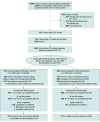Effect of the Wingman-Connect Upstream Suicide Prevention Program for Air Force Personnel in Training: A Cluster Randomized Clinical Trial
- PMID: 33084901
- PMCID: PMC7578767
- DOI: 10.1001/jamanetworkopen.2020.22532
Effect of the Wingman-Connect Upstream Suicide Prevention Program for Air Force Personnel in Training: A Cluster Randomized Clinical Trial
Abstract
Importance: Suicide has been a leading manner of death for US Air Force personnel in recent years. Universal prevention programs that reduce suicidal thoughts and behaviors in military populations have not been identified.
Objectives: To determine whether the Wingman-Connect program for Airmen-in-training reduces suicidal ideation, depression, and occupational problems compared with a stress management program and to test the underlying network health model positing that cohesive, healthy units are protective against suicidal ideation.
Design, setting, and participants: This cluster randomized clinical trial was conducted from October 2017 to October 2019 and compared classes of personnel followed up for 6 months. The setting was a US Air Force technical training school, with participants studied to their first base assignment, whether US or international. Participants in 216 classes were randomized, with an 84% retention rate. Data analysis was performed from November 2019 to May 2020.
Interventions: The Wingman-Connect program used group skill building for cohesion, shared purpose, and managing career and personal stressors (3 blocks of 2 hours each). Stress management training covered cognitive and behavioral strategies (2 hours). Both conditions had a 1-hour booster session, plus text messages.
Main outcomes and measures: The primary outcomes were scores on the suicidal ideation and depression scales of the Computerized Adaptive Test for Mental Health and self-reports of military occupational impairment. Class network protective factors hypothesized to mediate the effect of Wingman-Connect were assessed with 4 measures: cohesion assessed perceptions that classmates cooperate, work well together, and support each other; morale was measured with a single item used in other studies with military samples; healthy class norms assessed perceptions of behaviors supported by classmates; and bonds to classmates were assessed by asking each participant to name classmates whom they respect and would choose to spend time with.
Results: A total of 215 classes including 1485 individuals (1222 men [82.3%]; mean [SD] age, 20.9 [3.1] years) participated; 748 individuals were enrolled in the Wingman-Connect program and 737 individuals were enrolled in the stress management program. At 1 month, the Wingman-Connect group reported lower suicidal ideation severity (effect size [ES], -0.23; 95% CI, -0.39 to -0.09; P = .001) and depression symptoms (ES, -0.24; 95% CI, -0.41 to -0.08; P = .002) and fewer occupational problems (ES, -0.14; 95% CI, -0.31 to -0.02; P = .02). At 6 months, the Wingman-Connect group reported lower depression symptoms (ES, -0.16; 95% CI, -0.34 to -0.02; P = .03), whereas the difference in suicidal ideation severity was not significant (ES, -0.13; 95% CI, -0.29 to 0.01; P = .06). The number needed to treat to produce 1 fewer participant with elevated depression at either follow-up point was 21. The benefits of the training on occupational problems did not extend past 1 month. The Wingman-Connect program strengthened cohesive, healthy class units, which helped reduce suicidal ideation severity (estimate, -0.035; 95% CI, -0.07 to -0.01; P = .02) and depression symptom scores (estimate, -0.039; 95% CI, -0.07 to -0.01; P = .02) at 1 month.
Conclusions and relevance: Wingman-Connect is the first universal prevention program to reduce suicidal ideation and depression symptoms in a general Air Force population. Group training that builds cohesive, healthy military units is promising for upstream suicide prevention and may be essential for ecological validity. Extension of the program to the operational Air Force is recommended for maintaining continuity and testing the prevention impact on suicidal behavior.
Trial registration: ClinicalTrials.gov Identifier: NCT04067401.
Conflict of interest statement
Figures


Comment in
-
Hard Truths About Suicide Prevention.JAMA Netw Open. 2020 Oct 1;3(10):e2022713. doi: 10.1001/jamanetworkopen.2020.22713. JAMA Netw Open. 2020. PMID: 33084895 No abstract available.
References
-
- Smolenski DJ, Reger MA, Alexander CL, et al. DoDSER: Department of Defense suicide event report—calendar year 2012 annual report. Published December 20, 2013. Accessed September 25, 2020. https://www.dspo.mil/Portals/113/Documents/2012-DoDSER-Annual-Report.pdf
-
- Pruitt LD, Smolenski DJ, Tucker J, et al. DoDSER: Department of Defense suicide event report—calendar year 2017 annual report. Published July 12, 2018. Accessed September 25, 2020. https://www.dspo.mil/Portals/113/Documents/2017-DoDSER-Annual-Report.pdf...
Publication types
MeSH terms
Associated data
LinkOut - more resources
Full Text Sources
Medical
Miscellaneous

